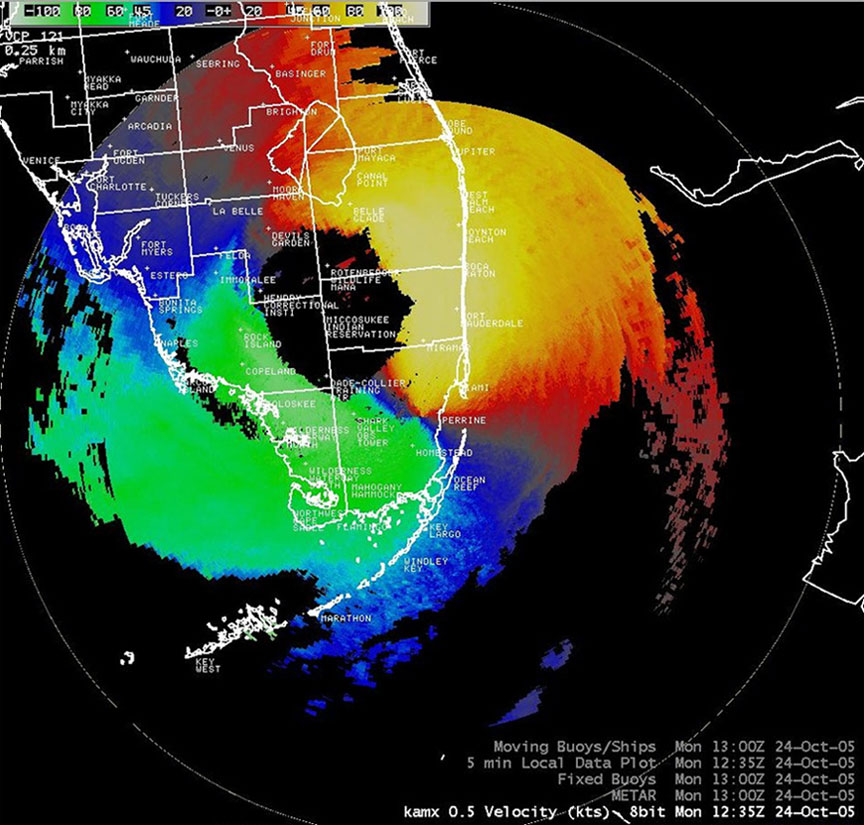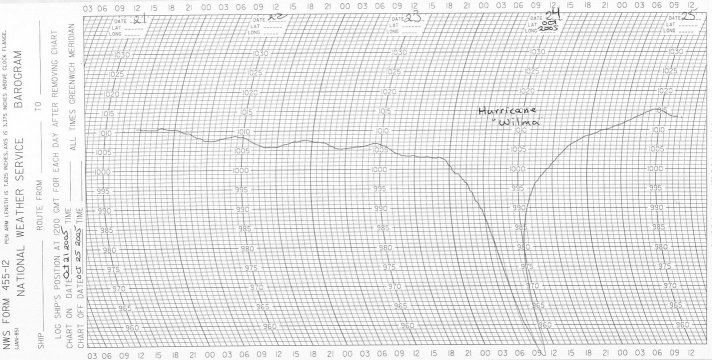From The PMO Desk: Hurricane Wilma
Peggy Alander, Port Meteorological Officer, National Weather Service, Port Everglades, FLIt was a dark and stormy night. Actually no it wasn't. It was yet another beautiful, balmy south Florida day when Tropical Depression 24 formed southwest of Jamaica on October 15. Within 48 hours, Wilma became the 21st named storm of the 2005 hurricane season. This tied the previous record set in 1933 for the most named storms in one season. Wilma was tracking to the west-northwest, and, at one point, within 24 hours had intensified from a 60 kts tropical storm to a Category 5 hurricane with winds of 150 kts. The central pressure had dropped to 882 millibars, and her eye was 2 miles wide. This was a storm to watch carefully.
I had many reasons to be concerned with Wilma. First, the Hurricane Center was projecting her path over the Yucatan and south Florida. Second, most of my VOS ship routes are in the Caribbean and Gulf of Mexico, but I knew that every mariner and their loved ones were keeping a watchful eye on the weather reports and forecasts. Third, my husband and I were scheduled to go on our very first cruise for our 24th anniversary to Cozumel, where we were to go deep sea fishing. I am giving away my age here, but we married young.
As Wilma continued on her west-northwest track, the eye went over Cozumel. We all know she devastated the Yucatan for two days before making her track for south Florida. I started emailing my VOS ships, and even some friends who thought they were not getting enough information about Wilma's track. It was physically impossible for me to climb the gangways after just having a fairly major operation, leaving me with limited mobility and no feeling in my left arm. Port Everglades had closed, so there was nothing more I could do except continue my emails, keep an eye on the weather reports, and pray and hope for the best.
We had just bought our house, and it had no hurricane shutters. Being prudent and cautious, my husband went to the local hardware store, bought plywood, and proceeded to board up the house. This was right when Wilma was moving offshore of the Yucatan. I recall one of my neighbors coming over and asking "What was he doing that for?" He then proceeded to tell me how wrong the track was and was busting on the NHC forecasters. He didn't know I work for the best weather service in the world. After I told him he got real quiet, and that night he began putting up his plywood.
On October 23, there was no doubt about it. South Florida was going to get hit. It was just a matter of how hard. I sent out emails until it was time to shut down and unplug my home computer. We lost power the morning of the 24th. Winds from the southeast were incessant. My newly planted palm trees were in tatters. I had been hoping that the rickety shed out back would get damaged so we could get it replaced. I learned to be careful what I hoped for as a huge slash pine snapped in half, bounced off the shed roof and got lodged between the shed and three other pines. It was totaled. Standing on the leeside of the house, we also watched the Sears metal shed disintegrate. This wasn't fun anymore. The barograph pressure trace kept falling, and I thought it was going off the chart.
The southeast winds subsided as the eye passed over my house. Of course we had to go outside. It wasn't a clear blue eye as there was some low stratocumulus clouds overhead, but it was eerie. Eventually, everyone in the neighborhood came outside. There was some damage-our shed being the worse so far, but everyone was all right.
The backside of the eyewall came with a vengeance. A gust came out of the northwest, and we all ran back to our homes. Within minutes our neighbor's screened porch literally blew off his house, onto his roof and then across the street. Ours peeled up like a Spam can. Time wise, I don't know how long we endured those winds. All I know is it was too long. When it was all said and done, sustained wind speeds had reached at least 74 kts near Miami, 61 in Fort Lauderdale, and 71 in West Palm Beach. Peak gusts were 91, 98, and 88, respectively. Eventually Wilma moved offshore and I didn't know or care to where.
The next few days were crazy. South Florida was without power. Gas was pretty much not available. People were urged to stay off the streets, and curfews were put in effect. Port Everglades remained closed. At least Wilma had brought some good cold air in behind her, making clean up efforts bearable. My husband and I decided to go to central Florida, where my dad lives, to get a generator, gas, a hot meal, and a hot shower. When we finally found a place that had generators, my husband told me to stand by the floor model and not move because it was ours. I thought he was crazy, but being a good wife, I stood there as he went off to procure it. When he came back and told me they were getting us two in boxes (one was for our good friends in Stuart), I moved away. That generator was instantly snatched up by a young man from Miami, who had been watching, just waiting for me to leave.
We left the next morning clean and full with our load of goodies, including the two generators, 50 gallons of gas, 100 pounds of charcoal, a gallon of lighter fluid, a Coleman campstove and lots of ice. We had the foresight to empty the minimal contents of the refrigerator, so at least we didn't have to deal with that when we got back. The lines for gas at the turnpike plazas were miles long. On the drive back, I got the call that Port Everglades was open for tenants to do damage assessments. The stark reality had set in that this was going to be a long haul. My office was fine, other than forgetting to unplug my computer which had died, there was no damage. However, the hallway and many of the other offices on the 3rd floor were flooded because the roof had not been fixed since Katrina blew the air conditioner off back in August. To this date it still floods out those same offices every time it rains.
Florida Power and Light was doing its best, and power was slowly coming back on throughout south Florida. It was time for me to see if we were still going cruising. When I called Carnival, I was told, yes, we were definitely going to Key West, but probably not to Cozumel. That would be fine, at least we could escape from reality for a little while.
We had heard that the Keys had flooded, but information was sparse. We had lived there for 12 years, with quite a few storms but never any flooding. Ours was the first ship back to Key West since Wilma, but, while the downtown area had cleaned up, we were greeted with over four inches of rain. Add that to an already deluged area and water was bubbling up through the streets. We waded through and did our daughter's shopping list then went back on board. It was disheartening. Later reports showed Key West sustained winds of 62 kts with gusts to 72. Fort Jefferson gusted to 116 kts. Flood waters reached up to 6.5 ft in Key West. The Lower Keys had up to 8 ft. Marathon had 9.5 ft and the Upper Keys had up to 5 ft.
Our cruise continued to Playa de Carmen, and the destruction there left me speechless. Concrete power poles were snapped in half, and miles of trees were toppled. Again, we were the first ship in since Wilma, and the Mexican people were so happy to have some tourists. My husband and I proceeded with our plans to go fishing anyway and caught some decent Kingfish and Bonita. All too soon it was time to go back to reality and back to work. When we got home the power had come on-it was only out for ten days and for some reason our brand new well pump system had imploded. Something else to deal with.
Things were getting back to normal at Port Everglades and Miami. Container and tanker ships were coming in and offloading their valuable cargo. One thing out of the norm though was tanker trucks got police escorts to their destinations. My arm was strong enough to hold onto a ladder, so at last I could go talk with some ships to find out how they fared and where they had diverted to. Everyone had high praise for the Hurricane Centers accuracy with Wilma's track. I think that a lot of the credit goes to the ships that send in observations. They help out the forecasters so much. I have even had ships that do not participate in the VOS program FAX and email me observations when they are within 300 nmi of a system. Every mariner knows how important and vital a role the weather plays. Every observation is important, even if the weather is great!
As I wrote earlier, when Wilma left Florida, at the time I did not know or care where she went. Over Christmas we went to the Bahamas. We pulled up to the port, and the first things we noticed were the fallen trees and the large amount of shingles waiting to be picked up. We knew where she went. The wrath of Wilma carried on.
It took Wilma four hours to traverse the south Florida peninsula. It will take months, maybe years for things to get right-if they ever do. But south Florida was given lots of notice and time to prepare. In part, because of the great weather observations that the ships relay, and for that we can't thank you enough.

Image courtesy of http://www.srh.noaa.gov/mfl/events/wilma/Wilma_V.jpg

